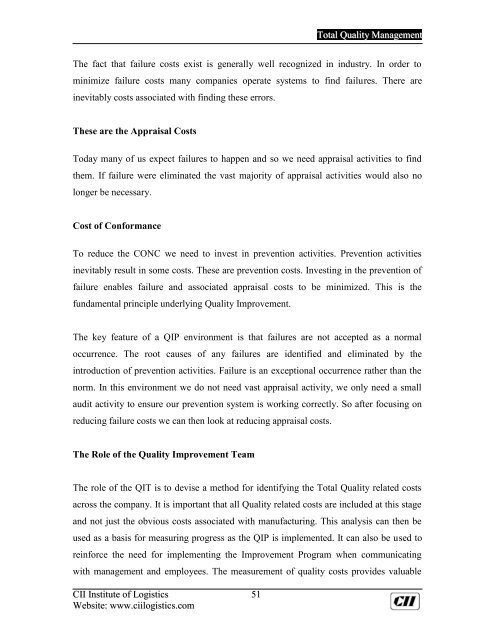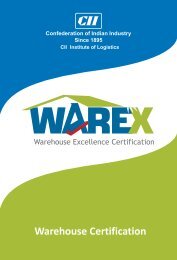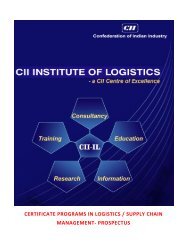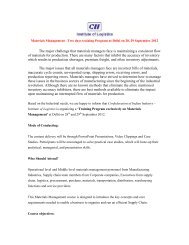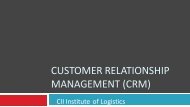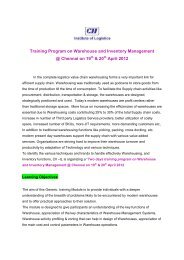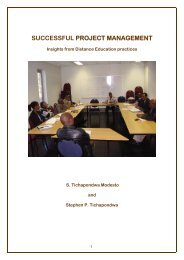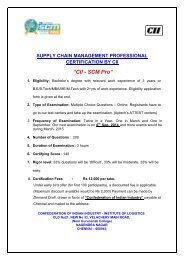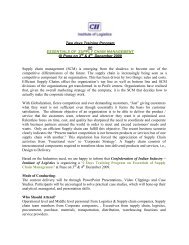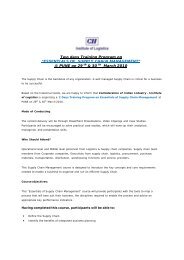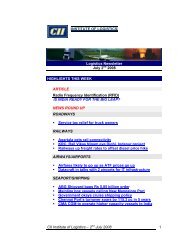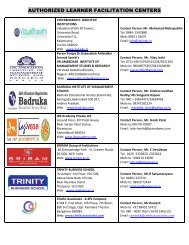Total Quality Management - CII Institute of Logistics
Total Quality Management - CII Institute of Logistics
Total Quality Management - CII Institute of Logistics
Create successful ePaper yourself
Turn your PDF publications into a flip-book with our unique Google optimized e-Paper software.
<strong>Total</strong> <strong>Quality</strong> <strong>Management</strong><br />
The fact that failure costs exist is generally well recognized in industry. In order to<br />
minimize failure costs many companies operate systems to find failures. There are<br />
inevitably costs associated with finding these errors.<br />
These are the Appraisal Costs<br />
Today many <strong>of</strong> us expect failures to happen and so we need appraisal activities to find<br />
them. If failure were eliminated the vast majority <strong>of</strong> appraisal activities would also no<br />
longer be necessary.<br />
Cost <strong>of</strong> Conformance<br />
To reduce the CONC we need to invest in prevention activities. Prevention activities<br />
inevitably result in some costs. These are prevention costs. Investing in the prevention <strong>of</strong><br />
failure enables failure and associated appraisal costs to be minimized. This is the<br />
fundamental principle underlying <strong>Quality</strong> Improvement.<br />
The key feature <strong>of</strong> a QIP environment is that failures are not accepted as a normal<br />
occurrence. The root causes <strong>of</strong> any failures are identified and eliminated by the<br />
introduction <strong>of</strong> prevention activities. Failure is an exceptional occurrence rather than the<br />
norm. In this environment we do not need vast appraisal activity, we only need a small<br />
audit activity to ensure our prevention system is working correctly. So after focusing on<br />
reducing failure costs we can then look at reducing appraisal costs.<br />
The Role <strong>of</strong> the <strong>Quality</strong> Improvement Team<br />
The role <strong>of</strong> the QIT is to devise a method for identifying the <strong>Total</strong> <strong>Quality</strong> related costs<br />
across the company. It is important that all <strong>Quality</strong> related costs are included at this stage<br />
and not just the obvious costs associated with manufacturing. This analysis can then be<br />
used as a basis for measuring progress as the QIP is implemented. It can also be used to<br />
reinforce the need for implementing the Improvement Program when communicating<br />
with management and employees. The measurement <strong>of</strong> quality costs provides valuable<br />
<strong>CII</strong> <strong>Institute</strong> <strong>of</strong> <strong>Logistics</strong> 51<br />
Website: www.ciilogistics.com


